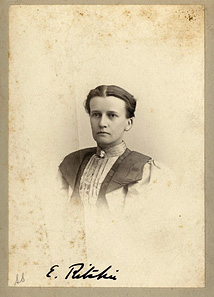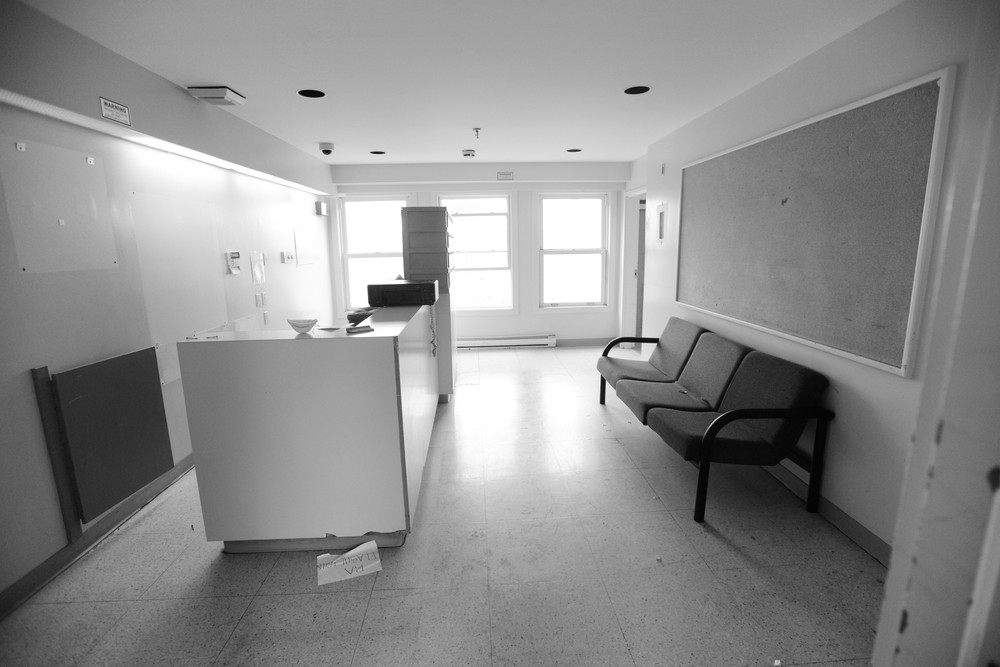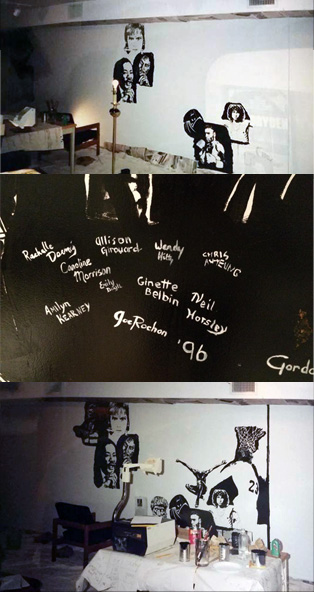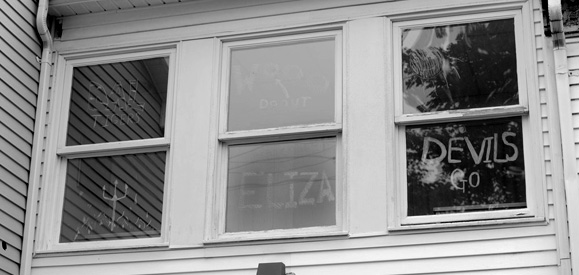Jen BondÔÇÖs first memory of Eliza Ritchie Hall is pulling up to the building in her uncleÔÇÖs pickup truck on her first day at Dal in September 2002.
ÔÇťThe first thing I saw was this huge banner hanging from the front part of the residence with a giant red devil on it,ÔÇŁ she says, referring to her initial encounter with the houseÔÇÖs mascot. ÔÇťThe whole residence council was outside, helping all these nervous 18-year-olds feel welcome while they were blasting [Trooper song] ÔÇśRaise a Little HellÔÇÖ out of the windows.
ÔÇťI was like, ÔÇśI think IÔÇÖve found my people.ÔÇÖÔÇŁ
* * *
BondÔÇÖs anecdote is not unique: talk to just a few of the thousands of individuals whoÔÇÖve lived or worked in Eliza Ritchie Hall at some point over the past 28 years and youÔÇÖll hear similar stories. TheyÔÇÖll likely mention how being separated from most of campus by South Street (and not having their own dining hall) led to a community that turned its outsider streak into a point of pride. They may note how the residence tended to retain more students into their third and fourth years than other houses did, creating a sort of ÔÇťelder classÔÇŁ feel to the place. And many will tell you that when it comes to spirit and enthusiasm, Eliza Ritchie Hall was often unrivalled at ┬ÚÂ╣┤ź├Ż.
ÔÇťEliza was always a very special community,ÔÇŁ says Heather Sutherland, assistant vice-president of Ancillary Services, who oversees DalÔÇÖs residences as part of her portfolio. She also worked for several years in the ÔÇťfarmhouseÔÇŁ around which the residence was built, first as director of alumni affairs and subsequently with the universityÔÇÖs residence office when it was located there.
ÔÇťEliza students looked at themselves as family,ÔÇŁ adds Sutherland, saying its occupants always were ÔÇťa tight-knit group known for their spirit and participation.ÔÇŁ
 That Eliza spirit lives on in its alumni, but the rooms and hallways of the building have seen its last occupants. Earlier this month, Eliza Ritchie HallÔÇÖs final summer residents moved out. In a few weeks, the building itself will be torn down.
That Eliza spirit lives on in its alumni, but the rooms and hallways of the building have seen its last occupants. Earlier this month, Eliza Ritchie HallÔÇÖs final summer residents moved out. In a few weeks, the building itself will be torn down.
As outlined in the universityÔÇÖs , the Eliza Ritchie site has been flagged as the future home of ┬ÚÂ╣┤ź├ŻÔÇÖs new fitness centre for some time now ÔÇö an addition long-needed to address the fitness and recreation demands of a Dal community more than double the size it was when Dalplex opened in 1979. And so as other residences have seen major renovations in recent years, and new housing offerings like LeMarchant Place have been added, Eliza Ritchie has been marching towards the end of its noble service to the Dal community.
ÔÇťThe aesthetics might not have been the best [in its final years], but the community always won out,ÔÇŁ says Nicole Cross, who served as the residence life manager for Eliza Ritchie from 2007 until this past year. ÔÇťIt was a community where everyone knew everyone.ÔÇŁ
* * *
Eliza Ritchie Hall was conceived in the midst of a Halifax housing crunch in the mid-eighties. As outlined in a September 1985 Dal News article, students faced many challenges finding housing in a city with a vacancy rate below the national average for nearly a decade. While the vacancy in on-campus housing did improve somewhat the following year, the university had already committed to doing its part to improve matters by moving quickly to increase capacity with a new residence complex.
 Designed by architects Preston and Associates to blend in with the surrounding neighbourhood, the new residence was built around an existing ÔÇťfarmhouseÔÇŁ on the site. (Initially used as Dal office space, the interior of the house eventually became part of the residence proper, thereafter earning the nickname ÔÇťThe Hive.ÔÇŁ) The total cost for the construction was $1.4 million, with $485,000 coming from the Province of Nova Scotia as a donation through the universityÔÇÖs capital campaign underway at the time. The residence welcomed its first 84 residents in the fall of 1987, with an official opening ceremony on October 20 of that year featuring Premier John Buchanan and Dal President Howard Clark.
Designed by architects Preston and Associates to blend in with the surrounding neighbourhood, the new residence was built around an existing ÔÇťfarmhouseÔÇŁ on the site. (Initially used as Dal office space, the interior of the house eventually became part of the residence proper, thereafter earning the nickname ÔÇťThe Hive.ÔÇŁ) The total cost for the construction was $1.4 million, with $485,000 coming from the Province of Nova Scotia as a donation through the universityÔÇÖs capital campaign underway at the time. The residence welcomed its first 84 residents in the fall of 1987, with an official opening ceremony on October 20 of that year featuring Premier John Buchanan and Dal President Howard Clark.
To name the new residence, ┬ÚÂ╣┤ź├Ż looked to its past, and to one of its most noteworthy 19th-century alumni. Eliza Ritchie (b. 1856, d. 1933) earned her a Bachelor of Letters with first-class honours in Philosophy in 1887, just four years after women were first admitted to the university. She completed her doctorate at Cornell University in Ithaca, New York shortly thereafter, making her one of the first Canadian women to receive a PhD.
 Though Ritchie was a teacher for a decade or so, she focused much of her life on research and community activism. She was a staunch feminist, heavily involved in the womenÔÇÖs suffrage movement, and considered education and the arts her great passions. She believed the Maritimes should be to Canada what she felt New England was to the United States at the time: ÔÇťa centre for high thinking and for the fostering of art.ÔÇŁ
Though Ritchie was a teacher for a decade or so, she focused much of her life on research and community activism. She was a staunch feminist, heavily involved in the womenÔÇÖs suffrage movement, and considered education and the arts her great passions. She believed the Maritimes should be to Canada what she felt New England was to the United States at the time: ÔÇťa centre for high thinking and for the fostering of art.ÔÇŁ
Ritchie volunteered for HalifaxÔÇÖs Victoria School of Art (which would later become NSCAD University), was a charter member of the forerunner of the Art Gallery of Nova Scotia, and made many notable donations to ┬ÚÂ╣┤ź├ŻÔÇÖs art collection. She was the first woman to serve on DalÔÇÖs Board of Governors, was on the founding editorial board of the ┬ÚÂ╣┤ź├Ż Review, and was the first woman to receive an honorary degree from the university. When she became president of the ┬ÚÂ╣┤ź├Ż Alumnae Association in 1911, she spearheaded the establishment of Forrest Hall, the universityÔÇÖs first residence for women ÔÇö an accomplishment that helped make her an ideal choice for the name of a new womenÔÇÖs residence more than 75 years later.
* * *
That Eliza Ritchie Hall was a womenÔÇÖs residence when it first opened isnÔÇÖt surprising, and not just because of the legacy suggested by its name. In the 1980s, single-gender residences were the norm at ┬ÚÂ╣┤ź├Ż. The university even had separate administrators (dean of men and dean of women) to oversee student life on campus.
But times were changing, and Dal was increasingly behind them: by this point most Canadian universities had at least one co-ed residence environment, but ┬ÚÂ╣┤ź├Ż had none. After consultation with students, the DSU, administrators and alumni, the Board of Governors approved a pilot project for two co-ed spaces on campus in 1990. The first was Howe HallÔÇÖs Bronson House, and the second was Eliza Ritchie Hall.
Eliza made sense for the pilot, given its small size, but it meant a massive change to the residenceÔÇÖs character, almost overnight. Nick Pearce, an English student entering his second year of studies at Dal at the time (and a future Eliza Ritchie house president) was one of the first male students to move in.
ÔÇťYou had these women who had lived in this residence for a year or more, and all of a sudden all these boys were moving in,ÔÇŁ says Pearce, who today is a staff photographer with ┬ÚÂ╣┤ź├Ż Communications and Marketing. ÔÇťBut it was pretty relaxed. Guys behaved differently in Eliza Ritchie. It was really respectful.ÔÇŁ
 Those sentiments were echoed in a March 1991 ┬ÚÂ╣┤ź├Ż Gazette article looking back at the first year of co-ed residence life at Dal. The article noted a jump in the number of applications for co-ed spaces for the upcoming year and quoted Eliza residence assistant (RA) Pam Trueman saying the year-end tensions sheÔÇÖd seen in the past had dissipated. ÔÇťItÔÇÖs much more relaxed,ÔÇŁ she said. Fellow RA Kevin MacIntosh said male residents were learning to look at themselves differently: ÔÇťItÔÇÖs so much better than a single-sex residenceÔÇŽ itÔÇÖs the one real-life scenario.ÔÇŁ (Today, while there are select wings or houses that are reserved for male or female students, all of DalÔÇÖs residence buildings are co-ed.)
Those sentiments were echoed in a March 1991 ┬ÚÂ╣┤ź├Ż Gazette article looking back at the first year of co-ed residence life at Dal. The article noted a jump in the number of applications for co-ed spaces for the upcoming year and quoted Eliza residence assistant (RA) Pam Trueman saying the year-end tensions sheÔÇÖd seen in the past had dissipated. ÔÇťItÔÇÖs much more relaxed,ÔÇŁ she said. Fellow RA Kevin MacIntosh said male residents were learning to look at themselves differently: ÔÇťItÔÇÖs so much better than a single-sex residenceÔÇŽ itÔÇÖs the one real-life scenario.ÔÇŁ (Today, while there are select wings or houses that are reserved for male or female students, all of DalÔÇÖs residence buildings are co-ed.)
Eliza Ritchie HallÔÇÖs character would take shape from there. It eventually adopted its defining ÔÇťdevilÔÇŁ mascot, which replaced an initial penguin mascot. Over the years some of the residenceÔÇÖs popular traditions included an annual BBQ, a community banquet and outdoor movie screenings on the back of the building. As an example of how tight-knit a community it was, from the very beginning ElizaÔÇÖs residence council leaders would pool their individual honorariums together towards a fund to support additional programming or purchase new equipment for the lounge or kitchens.
And the fact that Eliza Ritchie was ever-so-slightly separated from the rest of campus, along with its smaller population, continued to define its character ÔÇö best embodied by the solidarity its students showed in always sitting together in the Shirreff dining hall.
ÔÇťIt was an incredible community,ÔÇŁ says Anne Bartlett, who was residence coordinator/residence life manager for Eliza from 1994 until 2001. ÔÇťThere was something unique about being a smaller building on its ownÔÇŽ Everybody respected one another.ÔÇŁ
* * *
(Click image to enlarge)
While Eliza Ritchie always hosted a vibrant group of students, one of its more famous features through the years was decidedly black and white.
For the past two decades, the residenceÔÇÖs downstairs lounge has featured a two-toned, wall-length mural full of iconic individuals and characters ÔÇö everyone from well-established ÔÇťlegendsÔÇŁ like Michael Jordan and John Lennon to of-their-time personalities like Olympic rower Silken Laumann and Brandon Lee as ÔÇťThe Crow.ÔÇŁ It even includes one Dal legend: Harold Weston, the card-checker at the Shirreff dining hall who has been with Food Services for nearly all of Eliza RitchieÔÇÖs lifespan.
 The sketches for the mural were hand-drawn by Gord Hannah, an RA in Eliza for three years in the mid-ÔÇś90s. The drawings were then painted on the wall by a team of students during Study Break 1996.
The sketches for the mural were hand-drawn by Gord Hannah, an RA in Eliza for three years in the mid-ÔÇś90s. The drawings were then painted on the wall by a team of students during Study Break 1996.
ÔÇťWe worked day and night,ÔÇŁ says Hannah, ÔÇťWe really wanted to do something special.ÔÇŁ ┬á
Hannah credits then-house president Mike Webster (better known by his frosh name ÔÇťElvisÔÇŁ) with suggesting the mural, part of a major revamp of the lounge made possible through some highly successful fundraising efforts by house council. All students who lived in Eliza Ritchie that year were invited to submit their ideas for who should be included in the mural via a sign-up sheet in the buildingÔÇÖs main lobby. Nearly all their suggestions were incorporated.
The creatorsÔÇÖ original thinking was that the mural would be updated each year with new personalities, but that didnÔÇÖt happen. Instead, it lived on as a unique time capsule into the popular iconography of the 1990s.
ÔÇťI canÔÇÖt believe itÔÇÖs still there after all this time,ÔÇŁ says Hannah with an enthusiastic laugh.
* * *
Like some of the muralÔÇÖs figures, Eliza Ritchie Hall began to show its age in recent years. Given the haste at which it was built, many saw the residence as a ÔÇťtemporaryÔÇŁ addition to DalÔÇÖs housing offerings, but as the years went by it continued to support students through rain, snow, sleet, hailÔÇŽ and hurricanes.
 Bond, who is now a lawyer based in Ottawa, remembers how students in Eliza pulled together when Hurricane Juan hit Halifax in the fall of 2003. Without power, and with a small section of the roof torn off in the storm, students made sure to check up on their fellow housemates and worked to limit the potential damage to personal belongings.
Bond, who is now a lawyer based in Ottawa, remembers how students in Eliza pulled together when Hurricane Juan hit Halifax in the fall of 2003. Without power, and with a small section of the roof torn off in the storm, students made sure to check up on their fellow housemates and worked to limit the potential damage to personal belongings.
ÔÇťFor years, we kept a piece of the roof hanging in the front lobby, with the signatures of all of us who lived in Eliza and were there during the hurricane,ÔÇŁ says Bond, who would serve as house president the following year.
She also recalls how dozens of Eliza students spent part of that week helping out at Fenwick Tower, then a Dal residence, forming a human chain down the buildingÔÇÖs many flights of stairs to help occupants cart out storm debris. It was a shining example of the spirited volunteerism and support that seemed to define ElizaÔÇÖs residents. ┬á
ÔÇťThe community was so strong,ÔÇŁ says Christine Squire, who was residence life manager for the building from 2001-2007. ÔÇťIt was a place where people could be who they wanted to be. Because it was so small, they felt comfortable to be who they were.ÔÇŁ
She says the fact the building lasted as long as it did is ÔÇťa true testament to people treating the building with respectÔÇŽ so many great students came out of that building.ÔÇŁ
* * *
A few weeks from now, that building will be no more.
The Eliza Ritchie name will live on in the , an award for outstanding female students entering their PhD studies first created in 1985 to mark the centennial anniversary of DalÔÇÖs first female graduates. As well, the university is considering how best it can re-purpose the Eliza Ritchie name on campus and continue to celebrate her legacy.
As for the impact of the residence itself, it continues in the success of its alumni, in those individuals whoÔÇÖve been inspired by its community spirit and gone on to do great things in their lives and careers.
Brandy Morrow gets to claim being one of the last of those Eliza Ritchie alumni, having served as an RA in the building for the past two years. (She also lived there in her first year on campus.) She says sheÔÇÖs sad to see the residence go, but that it will be nice to see the additional fitness facilities available to students.
ÔÇťOf the 92 students in Eliza, I was friends with almost every single one of them,ÔÇŁ she says.
Despite being separated by more than two decades from some of the residenceÔÇÖs earliest occupants, MorrowÔÇÖs description of Eliza RitchieÔÇÖs character is remarkably similar to her predecessors. She mentions the houseÔÇÖs tight-knit community, incredible spirit ÔÇö winning the inter-house O-Week competition last fall ÔÇö and that students who lived there learned to embrace their self-image as ÔÇťthe underdogsÔÇŁ on campus.
ÔÇťI think thatÔÇÖs what created such a great community atmosphere,ÔÇŁ says Morrow. ÔÇťWe were a wonderful residence to be reckoned with.ÔÇŁ

Photos:
Eliza Ritchie Hall present-day photos: Danny Abriel
Eliza Ritchie portrait: Library and Archives Canada
Mural landscape photo: Nick Pearce
Mural under construction: Ginette Pitcher
Eliza Ritchie Hall under construction: ┬ÚÂ╣┤ź├Ż Archives

